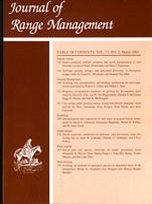Sage-grouse (Centrocercus urophasianus and C. minimus) historically inhabited much of the sagebrush-dominated habitat of North America. Today, sage-grouse populations are declining throughout most of their range. Population dynamics of sage-grouse are marked by strong cyclic behavior. Adult survival is high, but is offset by low juvenile survival, resulting in low productivity. Habitat for sage-grouse varies strongly by life-history stage. Critical habitat components include adequate canopy cover of tall grasses (≥ 18 cm) and medium height shrubs (40–80 cm) for nesting, abundant forbs and insects for brood rearing, and availability of herbaceous riparian species for late-growing season foraging. Fire ecology of sage-grouse habitat changed dramatically with European settlement. In high elevation sagebrush habitat, fire return intervals have increased (from 12–24 to > 50 years) resulting in invasion of conifers and a consequent loss of understory herbaceous and shrub canopy cover. In lower elevation sagebrush habitat, fire return intervals have decreased dramatically (from 50–100 to < 10 years) due to invasion by annual grasses, causing loss of perennial bunchgrasses and shrubs. Livestock grazing can have negative or positive impacts on sage-grouse habitat depending on the timing and intensity of grazing, and which habitat element is being considered. Early season light to moderate grazing can promote forb abundance/availability in both upland and riparian habitats. Heavier levels of utilization decrease herbaceous cover, and may promote invasion by undesirable species. At rates intended to produce high sagebrush kill, herbicide-based control of big sagebrush may result in decreased habitat quality for sage-grouse. Light applications of tebuthiuron (N-[5-(1,1-dimethylethyl)-1,3,4-thiadiazol-2-yl]-N,N′-dimethylurea) can decrease canopy cover of sagebrush and increase grass and forb production which may be locally important to nesting and foraging activities. The ability of resource managers to address sage-grouse habitat concerns at large scales is aided greatly by geomatics technology and advances in landscape ecology. These tools allow unprecedented linkage of habitat and population dynamics data over space and time and can be used to retroactively assess such relationships using archived imagery. The present sage-grouse decline is a complex issue that is likely associated with multiple causative factors. Solving management issues associated with the decline will require unprecedented cooperation among wildlife biology, range science, and other professional disciplines.
How to translate text using browser tools
1 January 2004
Ecology and management of sage-grouse and sage-grouse habitat
JOHN A. CRAWFORD,
RICH A. OLSON,
NEIL E. WEST,
JEFFREY C. MOSLEY,
MICHAEL A. SCHROEDER,
TOM D. WHITSON,
RICHARD F. MILLER,
MICHAEL A. GREGG,
CHAD S. BOYD
ACCESS THE FULL ARTICLE

Journal of Range Management
Vol. 57 • No. 1
January 2004
Vol. 57 • No. 1
January 2004
fire ecology
habitat
herbicide
landscape ecology
livestock grazing
population dynamics




